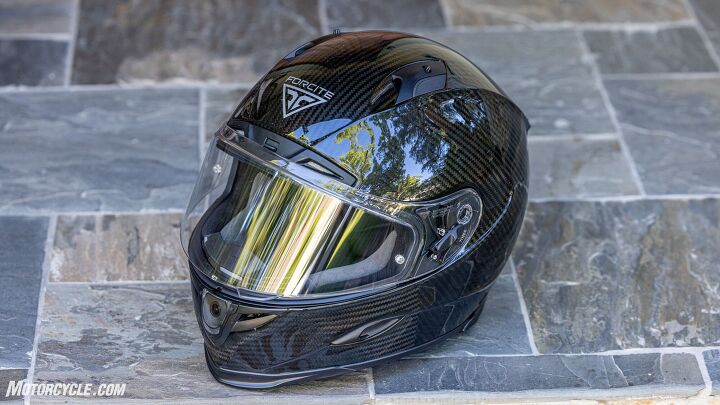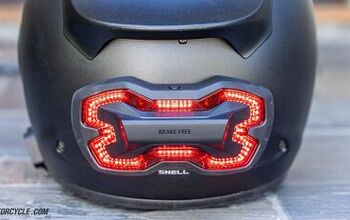MO Tested: Forcite MK1S Helmet Review

While perhaps the best smart helmet on the market, there is still room for improvement
I love technology, and as such, I’m very excited with the potential of smart helmets. We are just at the very beginning of what helmets can do for riders other than just protecting us from the elements when riding or impacts in a crash. Naturally, when Forcite approached me about reviewing the new MK1S helmet, I was immediately on board. The technology looks to be a great step along the path of smartening our lids. The Forcite MK1S offers the Bluetooth-smartphone integration many riders have become accustomed to and features a clever integration of LEDs to signal the rider important information without having to take their eyes off the road.
Forcite MK1S Helmet
The Forcite MK1S Helmet works better as a helmet compared to any other smart helmet I’ve tested, but the performance of the internal LED indicators and user interface need further work.
Editor's Score: 83%
Comfort/Fit | 8/10 | Value | 6.5/10 | Innovation | 9/10 |
Protection | 9/10 | Aesthetics | 8/10 | Weight | 8.5/10 |
Construction | 9/10 | Options | 8.5/10 | Weather Sutability | 8/10 |
Desirability | 8.5/10 | ||||
Highs
- Premium fit and finish
- Fits round to medium oval heads
- Good sound from speakers
Sighs
- LED indicators hard to see in daylight
- Uneven interface in app display/communication
- Map quality not as strong as more established map apps
- No rider-to-rider communication like with Bluetooth communicator systems
Helmet Construction and Fit
The Forcite MK1S is actually the second helmet released by the Australian company, but it is the first model to reach American shores. The outer shell is constructed of T-400 carbon fiber composite in either a matte or gloss finish. The MK1S looks every bit the premium helmet you would expect it is with a $1,099 price tag. The DOT certified interior is similarly appointed with sweat-wicking fabric that is quite comfortable. The interior is close to but not quite as nice as on other premium helmets, like Arai and Shoei. This is high praise for just the second helmet Forcite has produced to be so close to these more established brands.
Another feature I like about the MK1S is the small bottom opening. While this makes it a little tougher to don the helmet, it means the lower portion of the shell and comfort padding wrap around the bottom of my head better. When paired with the removable chin curtain, the noise and dust entering from the bottom of the helmet is minimized. Once through the opening, my head just pops into place.
The correct fit of a helmet to the human head is something that I’ve seen many new head protection manufacturers struggle with, and I’ve experienced some helmets that felt like the EPS impact absorption material was really wood. Not so with the Forcite. While the head shape of the 3D-formed cheek pads and crown is a little more on the round side than a medium oval, I was able to wear it with only a minor hotspot that I think will lessen as the miles progress.
One thing that did strike me as odd was the closeness of the chin bar to my face. My chin almost touches it, and if I open my mouth, my lower lip and chin hit the bar. I don’t know if this is because of the amount of electronics or the anti-shock construction of the electronics module or just because of the shape of the shell, but it is quite noticeable. In all my years of testing helmets, I’ve never experienced this on an XL helmet, and it prompted me to try on all of the street helmets I own to sample chin bar closeness. Only the Shoei X-Fifteen had the interior close enough for me to touch with my lips, and I really had to reach to do that.
The venting straddles the compromises required of trying to create air flow while maintaining a quiet helmet. There are two intake vents near the top of the head, two above the visor, and two on either side of the integrated chin bar camera. Exhaust vents consist of two on the sides of the chin bar and two at the rear of the helmet. Venting is good but not exceptional, and the noise generated by the vents is a bit louder than some helmets. A change to either increase the ventilation or decrease the noise would most likely negatively affect the other. As it stands, the MK1S is fine at elevated speeds with earplugs and, like its fit-and-finish, places it in the same neighborhood as more established premium helmets.
To sum up the Forcite MK1S helmet’s construction, the company clearly focused on having a quality lid to mount their electronics in, a step that other helmet upstarts have failed to achieve.
What Makes It Smart?
Starting with the smartphone connectivity that riders are most familiar with, the Bluetooth and Forcite app connected easily. Once paired, the phone’s music and calls behave as expected. Voice clarity to others via the dual microphones is good around town plus on the highway, and the quality of the sound out of the 40mm Harmon Kardon speakers is of a high quality. However, even with the extra spacers behind the speakers to move them closer to my ears, I didn’t feel the volume was loud enough, making conversations and directions hard to follow at highway speeds. I ended up placing two spacers behind the speakers moving them to about a finger’s width from my ear canal, and the results were a marked improvement. Perhaps this is why the Forcite X Master & Dynamic Speaker Upgrade Pack ($129) was created, but other than seeing this option on the Forcite website, I have no other knowledge about these speakers.
The MK1S’ smart features (and the camera) are probably why you’re reading this review, and the concept is pretty cool. Groups of LEDs mounted in the chin bar communicate a variety of messages. While most are self-explanatory, like green chaser lights going towards one side to signal the direction of an upcoming turn, you’ll want to spend a little time in the manual to understand and set the signals you want to receive. These signals can not only warn you of turns, but also about things like slow traffic ahead. To have this level of functionality, the app must be running on your phone. Herein lies both the strengths and weaknesses of the MK1S’ smart features.
To facilitate these features, the Forcite app uses its own map software with data drawn from HERE Technologies. However, my contact at Forcite said that will shift to Mapbox SDKs by the end of the year. As for their other data, I’ll let the rep explain:
Forcite developed and maintains its own geospatial backend services, which are responsible for aggregating road event data from a vast number of public data sources (including user-submitted road event data). Examples of data sources depend on regions, but typically council/government APIs and feeds provide a reliable source of up-to-date data (with a stable data model).
In my initial use of the app, I ran into problems experienced by many of the map systems not named Apple, Garmin, or Google. While the directions always got me to where I wanted to go, sometimes, just as I arrived at the destination, the vocal cues would pipe up and start telling me to do things like leave the parking lot that it just told me to enter and then go around the block. Fortunately, I could see my destination.
To confound things further, despite setting the app to display feet, the app consistently gave me verbal directions in meters. However, warnings would be in feet, causing ungainly announcements: “Bear left in 1 kilometer. Traffic stopped in 500 feet.” The display on the map itself was in miles. While the traffic/accident/police information was as accurate as those of the other map apps mentioned above, long-established traffic cams generated no warnings. That’s the bad news. The good news is that the fix is an app and/or firmware update away. We’ll see what happens when the SDK switches to Mapbox at the end of the year.
The audio interface is as good as any other mapping app I’ve used before, but the secret sauce of the Forcite MK1S is the LED notifications. At night, these signals were quite useful, though a bit dim. During the day, however, the LEDs are so dim that I struggled to see them with my peripheral vision and had to look directly at them – defeating the whole purpose of the LED system. Perhaps, a dark-tinted visor would help. However, I didn’t have one, and since it wouldn’t darken the eye port as much as night riding, I’m not sure a visor could get things dark enough.
I hope that the brightness issue is only a matter of firmware limiting the intensity and not an issue in which brighter LEDs need to be fit to the helmet. I am cognizant of the careful balancing act that Forcite must maintain in order to convey information without blinding the rider, but as it stands, the system is too conservative in its brightness. One final note: The frames of some glasses can partially obstruct the LEDs. So, I conducted all of my testing without glasses.
The Chinbar Camera
The other huge feature of the MK1S is chin bar-integrated camera (plus the smarts for all the other helmet’s features). Rather than mounting a camera on the outside of the helmet as is popular with GoPros – which can compromise a helmet’s integrity in a crash or catch in a slide and twist the rider’s head – the camera is an integral part of the helmet itself. In fact, Forcite claims that the camera’s construction combines with the battery and the other components in a separate module that is supported by an anti-shock mechanism which allows the shell to flex instead of crack on impact. This dispersion of energy all takes place without affecting the EPS liner. There’s another benefit of this construction that we’ll touch on later.
Offering HD 1080P resolution with 30-60 FPS frame rate via a ¼ inch Sony IMX Sensor, the camera system utilizes H.264 encoding and can write to microSD cards of up to 1T in size. The wide angle lens offers a viewing comparable to that of most action cams, while the dual microphones capture the engine noise or your narration while keeping the wind noise to a minimum. What isn’t like other current-generation action cams is the lack of 4K (or higher) resolution. Unfortunately, 1080P feels quite dated. What you’re paying for with the MK1S is convenience and safety. As a dash cam for commuters, the resolution will be fine but not for serious content creators.
The videos can be downloaded to your smartphone via a crazy, three plug cable and then edited in the Forcite app. Since most of my video doesn’t end up on social media but, rather, gets passed on to an editor to cut our bike review videos, I initially transferred the files to my laptop with the cable. Ultimately, I ended up just using a card reader to transfer from the microSD card.
So, how long does all of this technology last on a ride? Since I tend to charge all of my electronics prior to a ride, I never came up short on power during trips in which I was using all of the smart features except the camera. The camera however increased the power consumption. While I never killed the battery, Troy said in his review of the previous generation that he got up to four hours of recording out of the battery. My experience was similar.
A Unique Feature
Forcite has an aftercare program that looks to extend the value of a rider’s investment in a MK1S. If a rider crashes and damages their helmet, Forcite will verify that the tech components are fully functional and transfer them to a new shell, only charging for the new shell. Additionally, there are the app and firmware updates that the company will keep cranking out to improve the system’s functionality.
My time testing the Forcite MK1S has only reinforced my belief that smart helmets will be an integral part of riding in the not-to-distant future. However, the system is not without its issues, some of which (navigation idiosyncrasies) can be fixed via app/firmware updates, but in the case of the dim LEDs, the issue may be baked into the hardware. As far as being a premium helmet is concerned, Forcite hit very close to the mark of other more established manufacturers. Still, the chin bar being so close to the face is an unusual issue that individual riders may or may not be comfortable with. Regardless, the Forcite MK1S is the best example of smart helmet technology available, and I look forward to watching the company progress with its products. The Forcite MK1S is available in sizes XS-XL in gloss or matte carbon for a retail price of $1,099 direct from the manufacturer or from Tucker Powersports retailers.
FAQ
Are smart helmets worth it?
We are at the infancy of smart helmets, and consequently, the technology they pack is expensive. However, with features like a built-in camera and directional signals to help a rider navigate, smart helmets do offer value to a specific set of rider needs. If those align with yours, a smart helmet is worth it.
What are the cons of smart helmets?
The biggest issue with smart helmets, at this stage of their development, is their expense. Then there is the issue of needing to keep the battery charged prior to each ride.
What is the safest type of helmet?
A full-faced helmet is the safest because it protects more of your head and face. In the U.S., it must also meet DOT certification requirements to make sure it performs up to the required standard. While inexpensive helmets may meet the same standard, pricier ones offer more comfort features to make riding more enjoyable.
Related Reading
Crash Tested (With Video!): Forcite MK1 Smart Helmet Review
MO Tested: NUVIZ Head-Up Display Review
Quin Helmets and RapidSOS Team up to Decrease Response Times for Downed Riders
Motorcycle.com Mega Helmet Shootout
We are committed to finding, researching, and recommending the best products. We earn commissions from purchases you make using the retail links in our product reviews. Learn more about how this works.
Become a Motorcycle.com insider. Get the latest motorcycle news first by subscribing to our newsletter here.

Like most of the best happenings in his life, Evans stumbled into his motojournalism career. While on his way to a planned life in academia, he applied for a job at a motorcycle magazine, thinking he’d get the opportunity to write some freelance articles. Instead, he was offered a full-time job in which he discovered he could actually get paid to ride other people’s motorcycles – and he’s never looked back. Over the 25 years he’s been in the motorcycle industry, Evans has written two books, 101 Sportbike Performance Projects and How to Modify Your Metric Cruiser, and has ridden just about every production motorcycle manufactured. Evans has a deep love of motorcycles and believes they are a force for good in the world.
More by Evans Brasfield


































Comments
Join the conversation
Love the fully integrated camera, would be interested in a street and especially a dirt helmet that sports just that one feature - the rest I can live without.